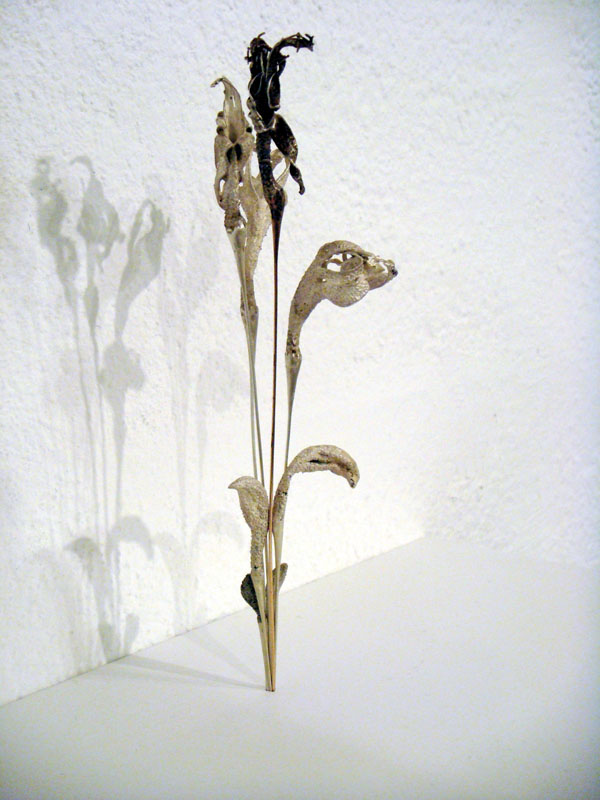
Sarah Elson's work is at once exquisitely beautiful and profoundly shocking. Not shocking in a spurious tabloid sense, but truly dread-full as the viewer is faced with first the beauty and the fragility of life and finally, inevitably with the bare fact of their own mortality.
Elson has cast from life an assortment of flowers, insects, seedlings and tiny creatures. These she has brought together in various configurations reminiscent of museum display, herbaria collections and the arrangement of objects on a mantelpiece. Her choice of the methodology of scientific enquiry for the presentation of the work dovetails nicely with the (modernist) grid arrangement of several of the works, for the business of artists such as Elson is, like science, an investigation into how the world works. But unlike science, Elson's enquiry encompasses the poetics of the soul side by side with the material world.
The casting process has rendered each once - living thing in the finest detail, right down to the hairs on the stems and petals of the kangaroo paw flowers, that apotheosis of all that is strange and 'other' about antipodean nature. If one of the reasons for creating art is to fly in the face of death, it is a nice paradox that in the process of casting the things themselves are destroyed, leaving only their forms rendered immortal in silver, copper and gold. One is reminded of the goal of the alchemists to transform gross matter into its purest state, searching for the key to everlasting life. But what I think Elson is drawing our attention to with all these tiny memorials is the wisdom and beauty to be found in our worldly existence, however fleeting that may be. Another kind of immortality is at work here. Not all the objects that she has cast are at the end of their life. The cicada skins in Nymphal Skin from a Hemiptera allude to transformation, the group of tiny seedlings in Accumulation of Succulents are just beginning, and the spent flowers, pods and buds in works such as Anigozanthos (eudaimonia hybrid) and Macropidia Fuliginosa are all way- stations in an endless cycle of renewal from seed to flower to seed again.
In the midst of this there is also untimely death. A dove chick and a tiny frog are two of the objects in Accumulation shelf. The dove chick lies curled in a parody of its embryonic shape, stopped before it really got me going. I was taken back to a park that I used to walk through regularly on my way to school as a child. Often in spring we would find dead chicks lying on the bitumen path beside a thick hedge. It wasn't sorrow, but curiosity that I felt at seeing these tiny bodies. It is as adults that we come to a deeper awareness of the hairsbreadth that divides life from death and feel its pathos most keenly. Sarah Elson, as a mother of young children is deeply involved in these life and death processes and in the 'stuff' of material life. Her fragile detritus is collected whilst walking with her children and a childlike curiosity and wonder is evoked by her assemblage of these tiny objects.
As Elson wants to remind us, material life can be a trap. She uses the word accumulation in a number of titles, and there is a strange anomaly amongst the spent flowers and ragged insect wings of Accumulation shelf - a cast credit card. So where does fulfilment lie in mortal life? The show's title work Anigozanthos (eudaimonia hybrid), contains a clue. Ric Spencer writes in the excellent catalogue essay that eudoaimonia means the desire to live a happy life. The Anigozanthos (kangaroo paw) has lived a right life according to its nature, is this where happiness lies? It's a good place to start.
Elson's beautiful and often witty work reminds us that as life is finite, that is all the more reason to live it mindfully and well.












